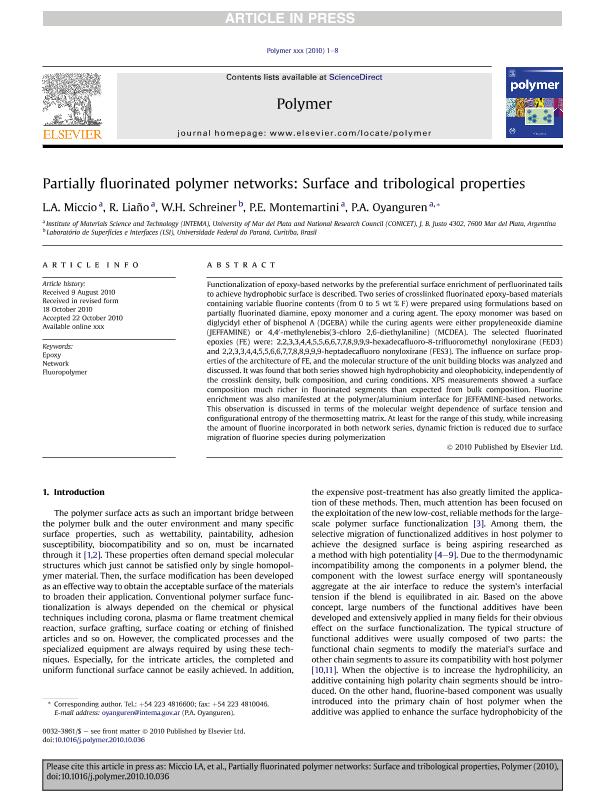Mostrar el registro sencillo del ítem
dc.contributor.author
Miccio, Luis Alejandro

dc.contributor.author
Liaño, R.
dc.contributor.author
Schreiner, Wido H.

dc.contributor.author
Montemartini, Pablo Ezequiel

dc.contributor.author
Oyanguren, Patricia Angelica

dc.date.available
2017-07-14T18:11:08Z
dc.date.issued
2010-10-28
dc.identifier.citation
Miccio, Luis Alejandro; Liaño, R.; Schreiner, Wido H.; Montemartini, Pablo Ezequiel; Oyanguren, Patricia Angelica; Partially fluorinated polymer networks: Surface and tribological properties; Elsevier; Polymer; 51; 26; 28-10-2010; 6219-6226
dc.identifier.issn
0032-3861
dc.identifier.uri
http://hdl.handle.net/11336/20636
dc.description.abstract
Functionalization of epoxy-based networks by the preferential surface enrichment of perfluorinated tails to achieve hydrophobic surface is described. Two series of crosslinked fluorinated epoxy-based materials containing variable fluorine contents (from 0 to 5 wt % F) were prepared using formulations based on partially fluorinated diamine, epoxy monomer and a curing agent. The epoxy monomer was based on diglycidyl ether of bisphenol A (DGEBA) while the curing agents were either propyleneoxide diamine (JEFFAMINE) or 4,4′-methylenebis(3-chloro 2,6-diethylaniline) (MCDEA). The selected fluorinated epoxies (FE) were: 2,2,3,3,4,4,5,5,6,6,7,7,8,9,9,9-hexadecafluoro-8-trifluoromethyl nonyloxirane (FED3) and 2,2,3,3,4,4,5,5,6,6,7,7,8,8,9,9,9-heptadecafluoro nonyloxirane (FES3). The influence on surface properties of the architecture of FE, and the molecular structure of the unit building blocks was analyzed and discussed. It was found that both series showed high hydrophobicity and oleophobicity, independently of the crosslink density, bulk composition, and curing conditions. XPS measurements showed a surface composition much richer in fluorinated segments than expected from bulk composition. Fluorine enrichment was also manifested at the polymer/aluminium interface for JEFFAMINE-based networks. This observation is discussed in terms of the molecular weight dependence of surface tension and configurational entropy of the thermosetting matrix. At least for the range of this study, while increasing the amount of fluorine incorporated in both network series, dynamic friction is reduced due to surface migration of fluorine species during polymerization.
dc.format
application/pdf
dc.language.iso
eng
dc.publisher
Elsevier

dc.rights
info:eu-repo/semantics/openAccess
dc.rights.uri
https://creativecommons.org/licenses/by-nc-sa/2.5/ar/
dc.subject
Epoxy
dc.subject
Network
dc.subject
Fluorinated Epoxy
dc.subject
Hydrophobicity
dc.subject
Fluoropolymer
dc.subject.classification
Recubrimientos y Películas

dc.subject.classification
Ingeniería de los Materiales

dc.subject.classification
INGENIERÍAS Y TECNOLOGÍAS

dc.subject.classification
Nano-materiales

dc.subject.classification
Nanotecnología

dc.subject.classification
INGENIERÍAS Y TECNOLOGÍAS

dc.title
Partially fluorinated polymer networks: Surface and tribological properties
dc.type
info:eu-repo/semantics/article
dc.type
info:ar-repo/semantics/artículo
dc.type
info:eu-repo/semantics/publishedVersion
dc.date.updated
2017-05-09T19:37:49Z
dc.journal.volume
51
dc.journal.number
26
dc.journal.pagination
6219-6226
dc.journal.pais
Países Bajos

dc.journal.ciudad
Amsterdam
dc.description.fil
Fil: Miccio, Luis Alejandro. Consejo Nacional de Investigaciones Científicas y Técnicas. Centro Científico Tecnológico Conicet - Mar del Plata. Instituto de Investigaciones en Ciencia y Tecnología de Materiales. Universidad Nacional de Mar del Plata. Facultad de Ingeniería. Instituto de Investigaciones en Ciencia y Tecnología de Materiales; Argentina
dc.description.fil
Fil: Liaño, R.. Consejo Nacional de Investigaciones Científicas y Técnicas. Centro Científico Tecnológico Conicet - Mar del Plata. Instituto de Investigaciones en Ciencia y Tecnología de Materiales. Universidad Nacional de Mar del Plata. Facultad de Ingeniería. Instituto de Investigaciones en Ciencia y Tecnología de Materiales; Argentina
dc.description.fil
Fil: Schreiner, Wido H.. Universidade Federal Do Parana; Brasil
dc.description.fil
Fil: Montemartini, Pablo Ezequiel. Consejo Nacional de Investigaciones Científicas y Técnicas. Centro Científico Tecnológico Conicet - Mar del Plata. Instituto de Investigaciones en Ciencia y Tecnología de Materiales. Universidad Nacional de Mar del Plata. Facultad de Ingeniería. Instituto de Investigaciones en Ciencia y Tecnología de Materiales; Argentina
dc.description.fil
Fil: Oyanguren, Patricia Angelica. Consejo Nacional de Investigaciones Científicas y Técnicas. Centro Científico Tecnológico Conicet - Mar del Plata. Instituto de Investigaciones en Ciencia y Tecnología de Materiales. Universidad Nacional de Mar del Plata. Facultad de Ingeniería. Instituto de Investigaciones en Ciencia y Tecnología de Materiales; Argentina
dc.journal.title
Polymer

dc.relation.alternativeid
info:eu-repo/semantics/altIdentifier/url/http://www.sciencedirect.com/science/article/pii/S0032386110009250
dc.relation.alternativeid
info:eu-repo/semantics/altIdentifier/doi/http://dx.doi.org/10.1016/j.polymer.2010.10.036
Archivos asociados
